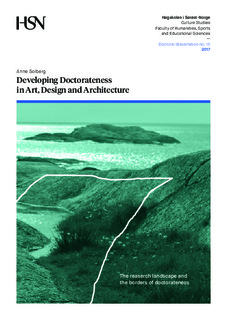| dc.description.abstract | The topic of this doctoral work is the collective effort leading to the establishment of doctoral qualifications in art, design, architecture and adjoining areas. These are fields that do not have the same academic traditions as the classical university disciplines, but now endeavour to obtain a position in academic society. The project is an investigation into how the making of art and design in doctoral works can respond to the criteria of doctorateness in European formal frameworks; in particular the Dublin Descriptors of the Bologna Process. This is the main objective of my analysis of nine doctoral theses, all including components of artworks. The theses originate from four higher education institutions in four European countries, representing different adaptations of the international frameworks.
Sources of information for the investigation include a broad range of publicly available documents, including international agreements, national and institutional regulations and doctoral theses. These are interpreted from a hermeneutic perspective in a structure of curriculum inquiry. The theses are analysed through a mapping process, relating them each to the other, and to the broader research landscape. Issues arising from the analysis include the purpose and results of the research projects, the research methods that are used, and the role of artworks and the making of art and design in the projects. These issues are related to a continuum between two extremes in the research landscape: on the one hand that art is research, and on the other hand that art can only be the object of research.
The analysis indicates that doctoral candidates within art, design and architecture regard their disciplines to be emerging research fields, and that proper research methods are not yet fully defined. As a consequence the candidates make substantial efforts towards defining and legitimating research methods for their projects. Art, design and architecture are dealing with our man-made environment from small scale to the planning of cities. This requires a broad variety of specialisms that cross the borders of academic domains – the humanities and the social and natural sciences. The artistic or creative practice tends to be an extra component, not included in these domains. This component of creative practice raises challenges for the making disciplines in their ambitions of meeting the demands of doctoral qualifications. The role of this element – the creative practice – in doctoral works is what I have investigated in my study.
The formal frameworks of qualifications tend to raise challenges for the development of doctorateness in these fields. What is seen through this study, is that conversely, the development of doctorates in art, design and architecture can also challenge the formal frameworks. The incorporation of creative fields into academia is affecting the conventional university disciplines, causing a debate on questions such as the role of the making of art and design in doctoral projects, the methods of research in the arts or artistic research, and whether to allow artworks to be included in doctoral submissions. These questions have not been solved by the development of international formal frameworks, and there are different national and institutional solutions. This study claims that there is a twin track in this development, a dynamic process between governmental regulations on the one hand, and academic expertise on the other.
What is seen in the analysis of the international formal frameworks in this study is that there is an ambiguity in the Dublin Descriptors of the Bologna Process: on the one hand are the formulation of the descriptors that indicate a conventional concept of doctoral qualifications. On the other hand is a wide and inclusive definition of research, underscoring that this term is not to be used in a conventional or ‘scientific’ way, added in a glossary in a footnote to the descriptors. For the interpretation of the Dublin Descriptors, I needed to clarify their formal status in order to decide whether they raise obligations for the Bologna Member States or not. For this purpose, I have studied the Bologna Process, not to clarify the forces and powers as such, but as a means of identifying the formal status of the Dublin Descriptors. | nb_NO |

